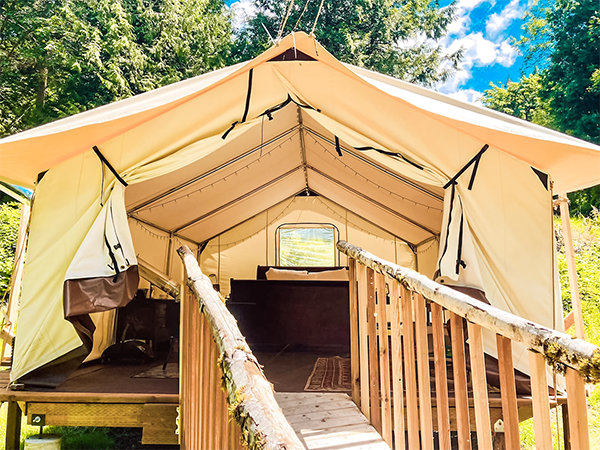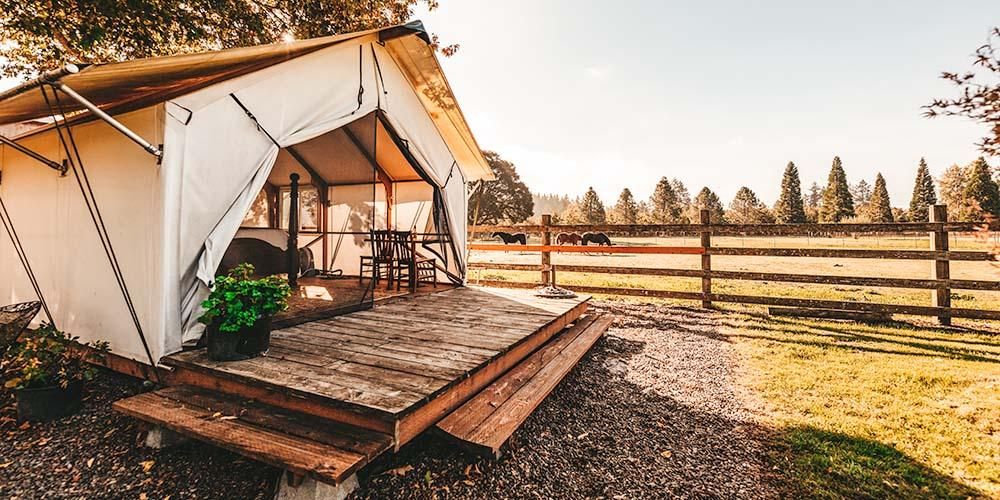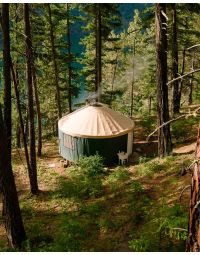Let's Talk About Glamping
Glamping is a fairly new concept that’s applied to a wide range of camping styles and preferences. The glamping experience is appealing to travelers who want the outdoor living experience, without traditional camping. When we hear the word camping we hear: getting lost in the great outdoors, covering basic food, water, and shelter needs, and roughing it in the woods. When we think of glamping, we envision an adventure that is a unique, accessible, comfortable, and sometimes luxurious outdoor experience.
We think the best way to explain the glamping business is to share a story from one of our recent Rainier Outdoor customers. Hidden Creek Hideaway is an up-and-coming glamping spot located in Poulsbo, Washington. Situated on four acres, the owners decided to create a unique hideaway for their close family, friends, and guests on the property. We met with the owners to gain some insight into the glamping business process from beginning to end. They shared useful information about locations for the glampsite, platform plans, tips and tricks for a bathroom, and preparation techniques for unexpected weather conditions.
Key Considerations Before You Begin
Choosing the Right Glamping Structure: Yurts, Tents, and More
The first thing you’ll want to plan is the structure! There are multiple self-assembling structures available for a glamorous camping plan. It all comes down to your budget and the amount of time you’re able to commit to during construction. If you’re looking for a long-lasting, permanent structure, we recommend that you check out our Rainier Outdoor yurt products. We recommend our Canvas Cottage, Teepee, or Centennial Wall Tent for those of you looking for an authentic glamping experience in a canvas structure. Whatever you decide, remember there are tent and yurt accessories for heating, cooling, and weatherproofing!
Selecting the Perfect Glamping Location
Our canvas products are manufactured to be pitched just about anywhere. Most folks seeking the ultimate glamping experience look for destinations that are “off the grid”. The owners at Hidden Creek Hideaway took this knowledge and pitched their wall tents in the middle of a wooded space on their property. The owners mentioned, “our house is nearby, but you can walk around the wall tent platform and see nothing but trees.” The 100% Army Duck Canvas used for our tent and cottage products provides the perfect aesthetic for getting lost in nature.
Building Platforms for Glamping Structures
Platform Price: $2,500 (not including labor costs)
It’s common to see yurt raisers and cottage builders construct platforms to host their glamping structures. However, we rarely come across wall tent customers that decide to build a permanent platform for their canvas hideaway! Our friends at Hidden Creek Hideaway found a way to create a unique platform for their wall tent. How long did it take? How’d they do it? They made various trips to the lumber store for treated lumber over six months. It’s important to use treated lumber in outdoor environments because it prevents mold and mildew from growing on your structure.






The flooring for their platform was built on a SIPS panel to keep the structure stable and dry in wet weather conditions. What’s a SIPs panel? Visit our blog ‘The True Cost of Building a Yurt: The Platform’ to learn more. Once the flooring was finished, they decided to add a rail from the front of the platform to an existing stump in the ground. Then, they added side rails to the outer parts of the wall tent to assist in holding down the rain fly in windy weather conditions. Our wall tent instruction manual suggests using the provided nails and ropes to stake down and secure the rain fly. The folks at Hidden Creek Hideaway found a creative alternative to securing their rain fly by tying the 12-foot ropes to the side rail.
A quick tip from Hidden Creek Hideaway, “Sometimes it’s helpful to go up instead of out with the tie-down straps if you don’t have enough land around the wall tent”. This was the main use for their side rails. The final step was to build a walkway that goes from a stump in the ground to the front door of the wall tent. A truly creative way to build a permanent structure with a Centennial Wall Tent!
Essential Decorations and Amenities for Glamping Guests
Glamping is different from camping because it requires less packing and lugging of necessary materials while on vacation. It’s important to decorate for your guests and prepare for various safety precautions during their stay. Decorating is arguably the most exciting step to building your glamping business. There are various ways to decorate a space in a way that keeps guests comfortable during their stay.






What should you include? When we think about glamping, we consider a bed, chairs, coat rack, extra blankets, and towels to be a few important amenities. Hidden Creek Hideaway did a wonderful job prepping their outdoor oasis with all of the necessary amenities to keep guests comfortable and happy during their stay. Check out AirBnb.com for a detailed list of the essential amenities to include in your glamping getaway.
Bathroom Setup and Solutions for Glamping Sites
It’s important to identify a nearby location for your restroom. We know it’s not the most glamorous part of the glamping business, but it’s important for keeping a fully booked calendar! There are many ways to accommodate a restroom. In this case, Hidden Creek Hideaway set up a composting toilet, shower, and sink in a nearby bathhouse.
As you can see, there’s a lot that goes into building your glamping business! Not to worry, the exciting thing about building your backyard glamping business is that it’s completely up to you to decide how you want to run it. The options for your structure, decorations, outdoor facilities, platforms, etc. are all up to you and your bandwidth. We hope this blog inspires your desire to become a glamping guru.
Please leave a comment below if you have questions and happy glamping!
Glamping Buisness FAQs
What is a glamping buisness?
A glamping business offers luxury camping experiences by providing upscale tents, cabins, yurts, or domes with amenities like beds, electricity, and bathrooms. It blends nature with comfort, attracting travelers who want an outdoor experience without sacrificing convenience or style.
How do I start a glamping business?
Start by researching your target market, selecting suitable land, acquiring the necessary permits, and choosing the right structures, such as yurts or canvas tents.
What structures are best for glamping?
Popular options include yurts, canvas cottages, safari tents, and geodesic domes, offering both comfort and a unique experience.
How much does it cost to start a glamping business?
Costs typically range from $10,000 to $100,000, depending on land, structures, and amenities.
What amenities should I offer at my glamping site?
Offer comfortable bedding, heating, private bathrooms, cooking facilities, and outdoor seating for a luxurious experience.
How do I choose a good location for a glamping site?
Look for scenic, private locations near nature, with access to utilities and outdoor activities that appeal to your target market.














